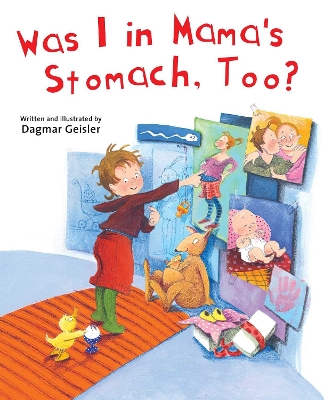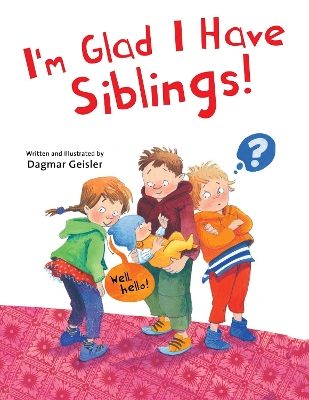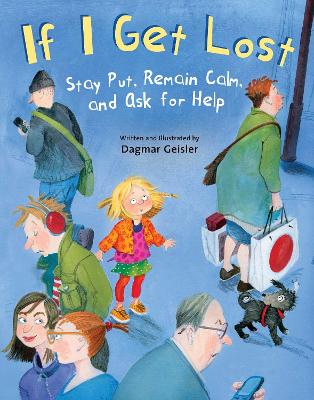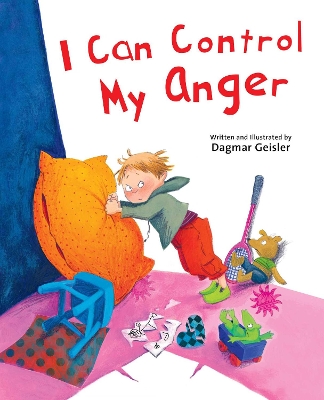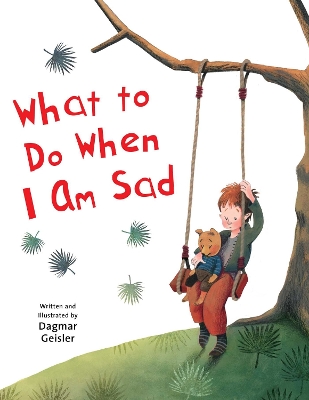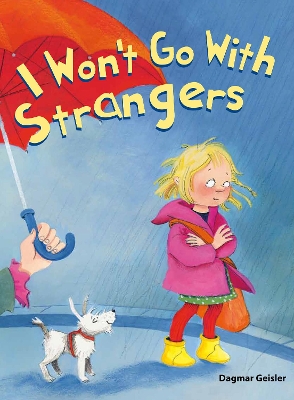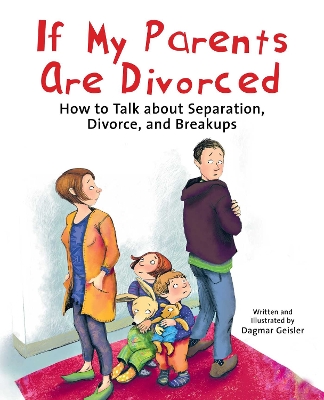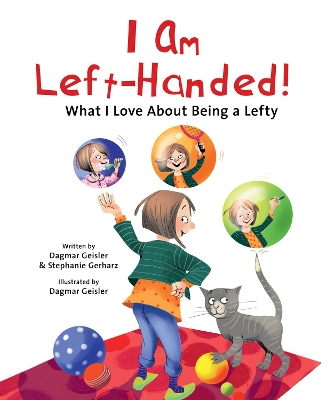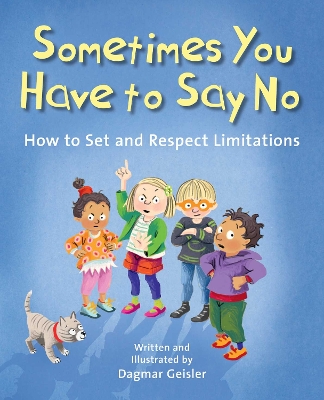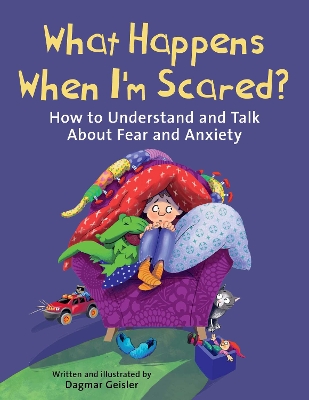The Safe Child, Happy Parent
15 total works
The perfect read for children who are curious about where babies come from and how they grow. When Mama's girlfriend, Lili, visited, I was surprised to see that Lili has a very round, rather big belly. "There's a baby growing in there!" Mama explained. "Was I in your stomach, too?" I asked. "Of course!" Mama says. "And was your stomach as big as Lili's?" Mama laughs. "I think my stomach was even bigger. You were a big baby when you were born . . . ." What could be more exciting than discussing where we come from and how we got here? Was I in Mama's Stomach, Too? gives parents, grandparents, and caregivers the opportunity to speak with children about this important topic, allowing children who are curious about science and nature to learn the answers to their questions about sexual attraction, reproduction, pregnancy and birth, as well as gain knowledge about one of the most fascinating processes in life.
Age range 3 to 6
We're lucky to have siblings!
At first, Mira was so excited when her new her baby brother came home with her parents, but her excitement quickly turned to frustration.
'Mom and Dad are constantly tired,' Mira tells her friends at school. 'And whenever they aren't tired, they have something to do: change diapers, feed the baby, put him to bed, dress him, undress him, rock him, cuddle with him, and worry when he cries for a long time. And no one has time left for me. It totally stinks!'
'I know all about it,' Hannah tells Mira. 'For us, it was exactly the same when my little brother was born. It's very normal.'
Hannah has an older sister and a younger brother. Paul has an older sister. Amelia has a big half-brother and a big half-sister.
And Theo is an only child and is happy to keep it that way.
With help from her friends, Mira realises that her parents are doing the best they can and that taking care of a baby can be challenging and rewarding at the same time - and that they still love her. The friends discuss the benefit of being an older or younger sibling, and how being in the middle means they can choose which group (older or younger) they want to be part of. Siblings make life more interesting, Mira's friends explain.
Age range 3 to 6
How do you know when you've had enough?
Lisa loves gummy bears, especially the yellow and red ones. And the green. And the orange. She would eat a whole bag of them if they didn't make her stomach ache.
Emma really enjoys swimming in the bathtub, but she knows exactly when she's been underwater long enough and needs to come up for air.
Tim loved the rabbit stuffed animal his grandmother gave him so much that he asked for another, and another, and now Tim isn't quite sure where his favourite stuffed rabbit is - and there's no room for him in the bed!
In Dagmar Geisler's I Want More-When To Know When I've Had Enough, readers will meet a number of children with interests similar to their own who learn to recognise when they've had enough or when they've had too much - when they've eaten too much of their favourite snack, collected too many of their favourite toys, or sat in front of the television for too long. Then, they can rank their favourite activities, toys, and foods using a scale of 'Too little!' to 'Enough already!', featured at the end of the book.
A thoughtful book that explains to children what to do if they are ever separated from their parents in public.
Lu is excited to go to the marketplace with Mama today. It's crowded, and she clings to Mama's red coat, but when she stoops for a second to pet the cutest little puppy, Mama is suddenly gone. She looks around quickly, but she can't find Mama. She does cross paths with a little boy, Roberto, who is also lost, and has been for a while.
Luckily, Lu knows just what to do to help herself and, now, Roberto. She recites the steps they must complete while Roberto dries his tears. Though Lu advises Roberto to stay put and to call his father on his cell, Roberto cannot remember his father's phone number--and Lu refuses to go with a stranger to his car where the man says she can use his phone. The next step is to find the police, not because Lu and Roberto are criminals, of course, but because the police will help Lu find Mama and Roberto find his father. Lu and Roberto must fight the urge to panic and trust that they'll be reunited with their parents shortly.
This sensitively narrated story illustrates how clear rules and arrangements can help protect and empower children during an especially vulnerable outing. The ending includes a straightforward list of steps children can memorize in case they are lost in the future, as well as prompts for parents to help prepare their children for this situation.
Do you sometimes get angry?
I do.
Sometimes I have such rage, I want to yell at the top of my lungs or shout at someone else. Sometimes I even want to shred something or stomp on it.
When I get angry, my heart beats faster than usual, I get hot, and my face turns as red as a tomato. Occasionally, I get cold and my hands shake when I am really frustrated and mad.
We all get angry, and we all feel that anger in different ways. We may get hot or cold. We may want to yell at our parents or our friends, or we may want to pout and not talk to anyone. We may want to punch pillows or we may just want to cry. Sometimes we know why we’re angry, and sometimes we don’t. And that’s okay.
This book sensitively teaches young readers about anger and shows them healthy ways to process and express their thoughts and emotions when they are mad. I Can Control My Anger provides parents, grandparents, teachers, and caregivers the opportunity to speak with children about this important topic.
Age range 4 to 8
A comprehensive, fully illustrated guide to our bodies — for boys and girls!
From a young age, children hear that pink is for girls and blue is for boys. They're told girls play with dolls and boys play with cars. Girls are always giggling and cuddling, while boys should be roughhousing and tough. Boys are messy and smelly and girls are giggling and cuddling, while boys should be roughhousing and tough. Boys are messy and smelly and girls are quiet and neat, right?
In My Body is Changing, Dagmar Geisler works to show preschool and early elementary readers that we're really not all that different, regardless of whether we're boys or girls. Though we may all seem similar on the outside, we are each our own person on the inside. At this age, our bodies and our minds are changing — we're growing up!
By getting to know the students of Class 4b, young readers will learn how their own minds and bodies work. They'll learn about friendship, about gender stereotypes, and about the rights they have, even (and especially) as children. Dagmar also addresses sexual abuse and why it's so important to report it to an adult.
Additionally, through stories and antics of the older siblings of Class 4b, readers will be introduced to the topics of puberty, falling in love, having sex, and becoming pregnant.
Dagmar Geisler's My Body is Changing is the perfect introduction to body awareness and sexual education for preschool and early elementary school students.
Age range 3 to 6
Have you ever been sad? We can be sad for many reasons. Maybe it's raining and you want to play outside. Maybe a friend moved away, or you're sick on your birthday.
Everyone feels sadness in different ways. You might feel like crying all the time, or you may be constantly cold or hungry. You might even feel sick to your stomach or angry. There's no right or wrong way to be sad.
One event that makes us all sad, regardless of how old we are or where we live, is losing a loved one. When someone we love dies, some people want to be alone, while others need company. Some people may want to hide under covers and do nothing all day, while others want to keep busy. Just like being sad, there's no right or wrong way to mourn.
In Dagmar Geisler's What to Do When I Am Sad, readers will learn to recognise why they're sad and how that sadness is making them feel otherwise. They will also learn that it's okay to express that sadness through tears, controlled anger, creativity, or conversation.
Lu won’t go with just anyone! She is waiting to be picked up after school. She stands on the sidewalk, all alone, and it starts to rain. Ms. Smith walks by, and offers to take her home. Ms. Smith lives in Lu’s neighborhood—but does Lu really know her? Lu asks herself, what’s her first name? Does she dye her hair red? What’s her dog’s name? And she says, “I don’t know you, so I won’t go with you! And besides, Mama said I should wait.”
As other adults—all of whom Lu has met in some capacity before—offer to take her home, Lu continues to consider if she really knows them. One by one, she refuses to go with them. Until, finally, the person Mama said she should go home with shows up—though his appearance is a surprise to the reader!
This sensitively narrated story illustrates how clear rules and arrangements can help protect and empower children during an especially vulnerable time of day. The ending includes a prompt for readers to create their own similar “safe” list, and a list of resources for parents.
Lisa loves gummy bears, especially the yellow and red ones. And the green. And the orange. She would eat a whole bag of them if they didn't make her stomach ache.
Emma really enjoys swimming in the bathtub, but she knows exactly when she's been underwater long enough and needs to come up for air.
Tim loved the rabbit stuffed animal his grandmother gave him so much that he asked for another, and another, and now Tim isn't quite sure where his favorite stuffed rabbit is—and there's no room for him in the bed!
In Dagmar Geisler's I Want More—When To Know When I've Had Enough, readers will meet a number of children with interests similar to their own who learn to recognize when they've had enough or when they've had too much—when they've eaten too much of their favorite snack, collected too many of their favorite toys, or sat in front of the television for too long. Then, they can rank their favorite activities, toys, and foods using a scale of Too little! to Enough already!, featured at the end of the book.
I Want More gives parents, grandparents, and caregivers the opportunity to speak with children about setting limits, allowing them to develop their own internal feeling for when something is no longer beneficial, fun, or healthy.
You can be angry for many different reasons—maybe a friend canceled a playdate with you, maybe it’s lightning when you’re supposed to be swimming, or maybe your dog destroyed your favorite toy. Maybe you’re upset that you’ve argued with a good friend, or maybe you're troubled when other kids are teasing or picking on you.
In I Can Stand Up to Bullies, children discuss the different things that make them upset and angry, specifically being the target of bullying from their peers. They clear up the confusion between arguing and bullying, determining that arguing means fighting caused by misunderstandings or conflicting opinions, while bullying is simply fighting to fight. A bully isn’t looking to solve a problem; they only wish to make others upset or angry—perhaps as upset or angry as they are feeling in that moment.
The children in this book teach each other important lessons they’ve learned through their own experiences with bullies, driving home the fact that bullying is never okay—but that it is always okay to find an adult if another child won’t leave them alone and is repetitively mean to them, no matter how embarrassed they may feel doing so.
In I Can Stand Up to Bullies, award-winning author and illustrator Dagmar Geisler draws attention to this sensitive subject and provides advice for not only the children who are being bullied, but also those who are witnessing their friends being picked on and the bullies themselves.
Have you ever been sick? Or do you know someone who has been sick for a long time? How do you take care of yourself when you're feeling ill? How can you get healthy again? How can you avoid getting sick in the first place?
When I Get Sick realistically addresses both infectious and chronic diseases, from the common cold to cancer. The children in this book discuss their different experiences with being sick so that every reader can find themselves on these pages. Children will learn about germs, viruses versus bacterial infections, and contagious versus noncontagious illnesses and issues. They'll see children attend doctor's appointments, experience blood tests and imaging, and even spend time in the hospital for surgeries. Preventative techniques such as handwashing, a healthy diet and exercise, and vaccinations are also discussed in detail.
Everything from ear aches, coughs and colds, tummy aches, chicken pox, the flu, diabetes, cancer, neurodermatitis, heart defects and asthma, to allergies, broken bones, and mental illness is discussed in this thoughtful and sensitive book.
In When I Get Sick, award-winning author and illustrator Dagmar Geisler presents the perfect opportunity for adults to talk to children about diseases, treatments, prevention, and how important it is to take care of their mind and body.
What happens when parents separate?
The idea of parents taking a break from or ending their relationship is scary and sad for children of all ages. The subject arises when Marie tells her kindergarten class that her neighbor's parents are going to separate. It's not an easy topic to discuss, and some kids around the table don't like to talk about what's happening, but Marie and her friends soon learn that they're not alone in their feelings or experiences and realize that they can share their fears and worries with their friends.
If My Parents Are Divorced shows how different families can deal with a separation and which insecurities may arise in the minds of children. The author gently conveys how important each child's feelings are and illustrates ways that the the child may feel better as time passes. This book is the ideal starting point for talking to preschoolers and grade schoolers about separations, divorce, and break-ups. It is designed to help children with their emotional development and to help process and understand their parents' decisions.
In If My Parents Are Divorced, award-winning author and illustrator Dagmar Geisler draws attention to this sensitive subject and provides advice for not only the children who are experiencing their parents' divorces, but also those who are witnessing their friends in these situations and want to provide listening ears and support.
How do you actually know whether you are left- or right-handed? Everyone has a "strong" side, after all. But what exactly does that mean, and how do you know which one works better for you? Why is it that so many misjudge themselves, or deny their true default?
This book explores left-handedness, a subject that is surprisingly sensitive to many—especially children who are surrounded by right-handed friends and classmates and who struggle with the need to use "special" scissors, worry about smudging their schoolwork, and grow frustrated with bumping elbows at the dinner table.
I Am Left-Handed answers common questions like:
- How do you know that you're left-handed?
- Is left-handedness genetic?
- If you're left-handed, are you also left-footed?
- What kind of products exist that are specially made for lefties?
- What does a handedness consultant do?
It's important to accept that you're a lefty and to love the fact that you're unique and special—only 10 percent of the world is like you!
In I Am Left-Handed!, award-winning author Stephanie Gerharz and author and illustrator Dagmar Geisler draws attention to what could be a sensitive subject to some and provides advice for not only the children who are left-handed but also those who live and work with them daily, like parents, grandparents, teachers, siblings, and caregivers.
Sometimes you're not interested in performing a task, going somewhere, or speaking to someone, so you say no.
But whenever Matilda, Emil, Lukas, and Taya refuse a piece of cake from their neighbor Mrs. Rose, she is offended.
Wouldn't it be better if everyone always said yes to everything? This way, no one would ever be sad or disappointed again!
When a mysterious wish on a shooting star magically makes the word no disappear, the children and their neighbors realize that life without saying no just isn't as enjoyable as they had envisioned.
In Sometimes You Have to Say No, award-winning author and illustrator Dagmar Geisler draws attention to what could be a sensitive subject to some and provides advice for not only the children who are often feel pressured to say yes, but also those who live and work with them daily, like parents, grandparents, teachers, siblings, and caregivers.
What is fear?
What does it feel like?
Can feelings of fear be passed on to others?
And can they return?
In What Happens When I’m Scared?, children take turns listing what scares them. They express their concern over the dark, big dogs, heights, spiders, monsters under the bed, bullies, extreme weather, and speaking in front of others.
Through discussing what they fear, they begin to understand why certain places, people, or circumstances make them feel nervous, worried, anxious, scared, or even nauseous. They learn about their body’s biological reactions, both physical and mental. And they determine that it’s absolutely okay to be afraid and that everyone, from babies to grandparents, is scared sometimes.
In What Happens When I'm Scared, award-winning author and illustrator Dagmar Geisler draws attention to what could be a sensitive subject to some and provides advice for overcoming fear that will be helpful to young readers as well as those who live and work with them daily, like parents, grandparents, teachers, siblings, and caregivers.
